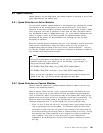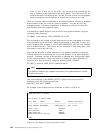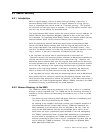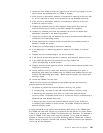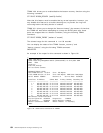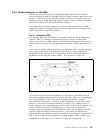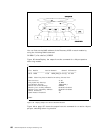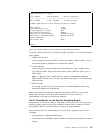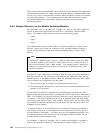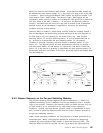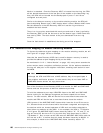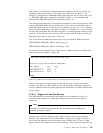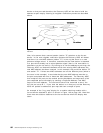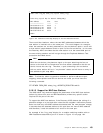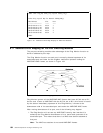
8260> show module 6.1 verbose
Slot Module Version Network General Information
----- --------------- ------- ------------- -------------------
06.01 T18PSA v1.00 PER_PORT Trunk(s) are down
T18PSA: Token Ring Active Port Switching Twisted Pair Module
Boot Version: v1.00
Ring Speed Dip Setting: 16 MBPS
Jitter Attenuator 1 Status: OKAY
Non-Volatile DIP Setting: ENABLED
Recovery Asic Primary Address: 08-00-8f-d0-e0-e2
Recovery Asic Secondary Address: 08-00-8f-d0-e0-62
Beacon Threshold: 7
Switch ASIC type: BASIC
8260>
Figure 96. Display Output for 18-Port Active Per-Port Switching Module
To perform beacon recovery, the Recovery ASIC operates in one of the following
three modes:
1. MAC frame monitor:
In this mode the recovery ASIC is listening for Beacon MAC frames. This is
the normal mode of operation for the Recovery ASIC.
2. Frame transmit:
In this mode the recovery ASIC can transmit Beacon Type 1 MAC frames.
The Recovery ASIC enters this mode when it sees a Beacon Type 2, 3 or 4
MAC frame.
Note: A Beacon Type 1 MAC frame is used for management purposes.
Beacon MAC frames from a normal ring station are type 2, 3 or 4 depending
upon the fault.
3. Manual mode:
This mode is used for ring reconfiguration with 8250 repeaters and using
proprietary 8250 trunk unwrapping.
Before describing the procedure used by the Recovery ASIC, to recover the
beaconing conditions, let′s review the ring monitor function which is
implemented on the per-port switching modules.
8.9.3.2 Ring Monitor on the Per-Port Switching Module
Ring monitor is a function which is employed on each port of the active per-port
switching module and the dual-fiber repeater module and is required to assist
the Recovery ASIC to perform beacon recovery on these modules.
Ring monitors have the responsibility to monitor their respective port for the
following:
•
The presence of a Beacon MAC frame
•
The presence of AMP/SMP (Active Monitor Present/Standby Monitor Present)
•
Tokens
Chapter 8. 8260 Token-Ring Support 157



